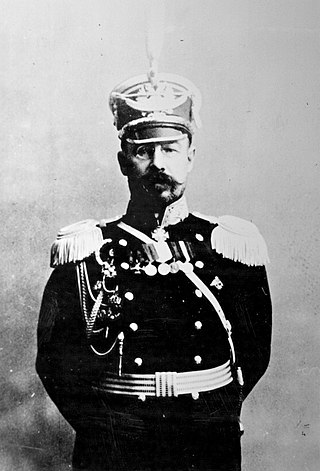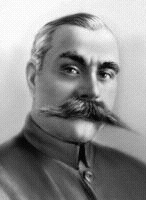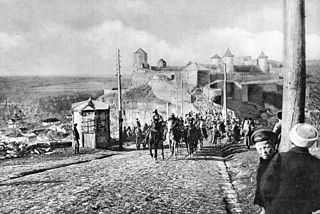
The Workers' and Peasants' Red Army, often shortened to the Red Army, was the army and air force of the Russian Soviet Republic and, from 1922, the Soviet Union. The army was established in January 1918 by Leon Trotsky to oppose the military forces of the new nation's adversaries during the Russian Civil War, especially the various groups collectively known as the White Army. In February 1946, the Red Army was renamed the "Soviet Army" – which in turn became the Russian Army on 7 May 1992, following the dissolution of the Soviet Union.

Anton Ivanovich Denikin was a Russian military leader who served as the acting supreme ruler of the Russian State and the commander-in-chief of the armed forces of South Russia during the Russian Civil War of 1917–1923. Previously, he was a general in the Imperial Russian Army during World War I.

Alexander Ilyich Yegorov or Egorov was a Soviet military leader and one of the original five Marshals of the Soviet Union.

Boris Mikhaylovich Shaposhnikov was a Soviet military officer, theoretician and Marshal of the Soviet Union. He served as the Chief of the General Staff of the Soviet Armed Forces from 1928 to 1931 and at the start of the Second World War. Shaposhnikov was one of the foremost military theorists during the Stalin-era. His most important work, Mozg Armii, is considered a landmark in Soviet military theory and doctrine on the organization of the Red Army's General Staff.

Nikolai Nikolayevich Yudenich was a commander of the Russian Imperial Army during World War I. He was a leader of the anti-communist White movement in northwestern Russia during the Civil War.

Mikhail Vasilyevich Alekseyev was an Imperial Russian Army general during World War I and the Russian Civil War. Between 1915 and 1917 he served as Tsar Nicholas II's Chief of Staff of the Stavka, and after the February Revolution, was its commander-in-chief under the Russian Provisional Government from March to May 1917. He later played a principal role in founding the Volunteer Army in the Russian Civil War and died in 1918 of heart failure while fighting the Bolsheviks in the Volga region.

Iona Emmanuilovich Yakir was a Red Army commander and one of the world's major military reformers between World War I and World War II. He was an early and major military victim of the Great Purge, alongside Mikhail Tukhachevsky.

Jukums Vācietis was a Latvian Soviet military commander. He was a rare example of a notable Soviet leader who was not a member of the Communist Party, until his demise during the Great Purge in the 1930s.

Mikhail Dmitriyevich Bonch-Bruyevich was an Imperial Russian and Soviet military commander. His family belonged to the nobility of the former Grand Duchy of Lithuania.

Sergey Sergeyevich Kamenev was a Soviet military leader who reached Komandarm 1st rank.
Mustang is a military slang term used in the United States Armed Forces to refer to a commissioned officer who began their career as an enlisted service member. A mustang officer is not a temporary or brevet promotion but is a commissioned officer who receives more pay according to their rank of O1-E, O2-E, etc., but has no more command responsibilities than those of any commissioned officer of the same grade.

Yakov Timofeyevich Cherevichenko was a Soviet military leader and colonel general.
Anatoly Ilyich Gekker was a Soviet military commander (Komkor) involved in the Russian Civil War.

Max Andreyevich Reyter was a Russian and Soviet military officer of Latvian origin.

The Operation Faustschlag, also known as the Eleven Days' War, was a Central Powers offensive in World War I. It was the last major offensive on the Eastern Front.

The Battle of Tsaritsyn was a military confrontation between the Red Army and the White Army during the Russian Civil War for control of Tsaritsyn, a significant city and port on the Volga River in southwestern Russia.

Yevgeni Andreyevich Iskritsky was a Russian and Soviet military commander, author, teacher, a hero of the First World War, lieutenant general in the Imperial Russian army, who fell in with the winning side in the Russian Civil War yet was still a victim of Stalin's purges.

Mikhail Alexandrovich Batorsky was a Red Army Komkor.

Ivan Naumovich Dubovoy was a Ukrainian Soviet army commander. He fought for the Imperial Russian Army in World War I before going over to the Bolsheviks in the subsequent Civil War. With fellow Ukrainian Ivan Fedko he secured his hometown for the Red Army. He was a recipient of the Order of the Red Banner.

Andrey Kirillovich Smirnov was a Soviet general who served as commander of the 18th Army, during World War II, lieutenant general.



















